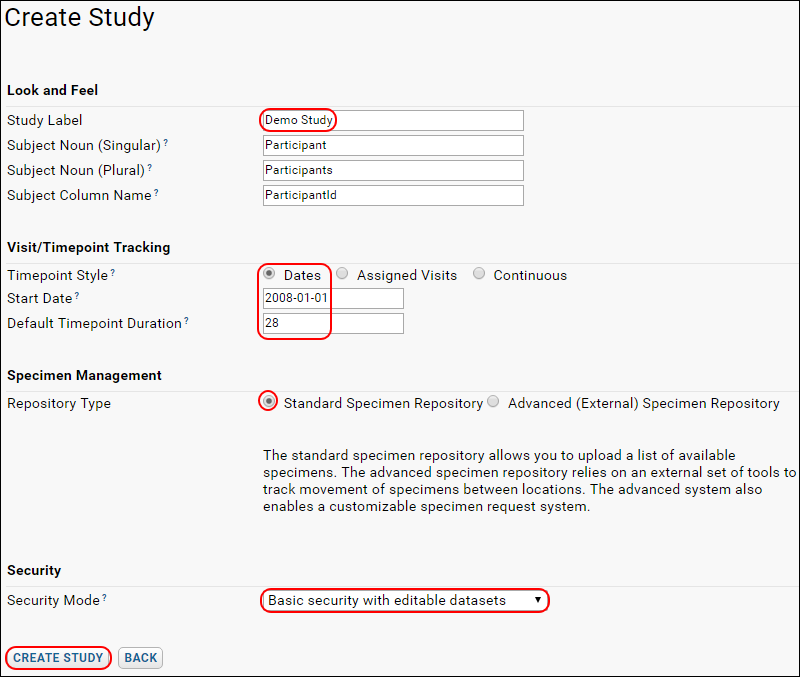In this step, you will create a "study repository". A study repository is a data container that understands concepts of Participant, Time, and Specimen. These concepts are used to align the data, creating a browsable whole out of the separate datasets. Below, you will decide on some basic properties for the concepts Participant, Time, and Specimen.
Participants
A study repository lets you choose the name used for Participants. The name you choose typically reflects the organism being studied, for example, "Mouse", "Mosquito", "Subject", etc. for the study below, we will use the name "Participant".
Time
LabKey Server provides three different "timepoint styles" for your data:
- Dates means that the data is grouped into time periods bounded by calendar dates. If your study has a variety of visits across patients, and no set naming system for visits, a Date-based style works best.
- Assigned Visits means that the data is grouped into named visit periods. No calendar dates need be present in the data, as the sequence of visit periods is determined by a series of decimal numbers, recorded in the "Sequence Number" field. Visit labels can be assigned to the Sequence numbers, for example, "Baseline Visit" can be the visit label for the Sequence number "0". If the participants in your study have a fixed number of visits, with a small amount of variability, a Visit-based style works best.
- Continuous is intended for open-ended observational studies that have no determinate end date or stopping point. This style is useful for electronic health record (EHR) data. If the study is ongoing with no strong concept of dividing time into fixed visits, then a continuous style works best.
Below we create a "Date" based study.
Specimens
A study repository provides two different ways to handle specimens:
- Standard specimen repository. The specimen inventory is simply copied to the server and linked to assays and participants.
- Advanced specimen repository. The specimen inventory is made available to outside investigators using a "shopping cart". Outside researchers can request specimen vials from your repository for their own testing. Requests are evaluated and fulfilled using a built-in workflow.
In the study below, you will create a simple specimen repository.
Set Up
Create a New Study Folder
Study folders contain tools to help you manage your study, organize your data and set up security so that only authorized users can see the data.
- Sign in to your LabKey Server and navigate to the Home project.
- Create a new folder to work in:
- Go to Admin > Folder > Management and click Create Subfolder.
- For the Name enter "Demo".
- For Folder Type select "Study".
- Click Next.
- On the Users/Permissions page, make no changes, and click Finish
- If you instead click Finish and Configure Permissions you will see the project configuration permission page. Make no changes there and click Save and Close to continue).
- Click the Create Study button.
Set Study Properties
Study properties allow you to store some basic information about your study, including a label, identifying information, a protocol document. You may also customize how individual participants in a study are described.
For this tutorial, set your study's properties to the values shown in the screenshot below. Notice that the word "Study" is appended automatically to the folder name you entered. Here you will create a date-based study with editable datasets and simple specimen tracking:
- Timepoint Style: Dates
- Start Date: 2008-01-01
- Default Timepoint Duration: 28 (days)
- Repository Type: Standard Specimen Repository
- Security Mode: Basic security with editable datasets

- Click the Create Study button to finish creating your study.
- You will initially land on the Manage tab.
Explanations of the remaining study properties
- Name: the name of your study appears in the top banner.
- Subject Noun: The subject noun typically indicates the organism being investigated, for examples, "Mouse", "Mosquito", "Participant". This noun will be used throughout the user interface of the study.
- Subject Column Name: The is the default column name containing subject ids. Your data does not need to conform to this column name. It is only the default used by the server.
- Specimen Repository Type: The Standard repository integrates your specimen data with the other datasets. Advanced repositories provide an additional specimen request management system.
- Security Mode: Provides security pre-configuration. You can change the security settings later on.